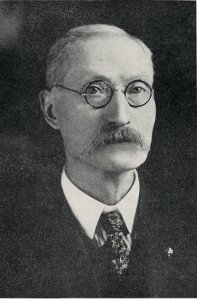Directing head and managing genius of several large and industrial enterprises at Rome, Oneida county, New York, William J. Doyle may with absolute truthfulness be characterized as a self-made man, which means that he worked his way upward without the adventitious aids of wealth or personal influence to make his progress an easy one. He was born in Rome on July 28, 1851, the son of Miles and Margaret (Kenney) Doyle, both natives of Ireland, who located at Rome in 1848, where the father engaged in farming. Mr. Doyle's father died in 1863 and his mother passed away in 1888.
William J. Doyle was the eldest of a family of six children, four sons and two daughters. He obtained his education in the public schools of Rome and in the parochial school, starting out when twelve years old to become self-supporting, his first employment being candy making, at which he spent two years. For a similar period he worked as "printer's devil" in the office of the Rome Sentinel and next spent several years in the service of A. Ethridge & Company. He was afterward employed in the office and machine shops of the Rome Rolling Mill Company and while there formed the desire to learn the machinist's trade. In 1869 he entered upon an apprenticeship in the shops of the Rome, Watertown & Ogdensburg Railroad Company and in 1876 became connected with the Aland Blower Company, with which he remained until 1879. The Mohawk Revolver Company failed at this time and, in association with Solomon Butler, Mr. Doyle bought the business and organized the Rome Revolver & Novelty Company, known then as the Fowler Shade Factory and located at No. 131 Henry street. A year later the building was sold to the Williams Brothers Knitting Company. Mr. Doyle bought out his partner's interest and moved his machinery to the Bingham block on East Front street. He remained there until shortly after the fire that destroyed the freight house of the New York Central Railroad in the fall of 1881. Then he moved his machinery to the rear of Nos. 103 and 105 East Dominick street, where he was located until 1908. In 1893 he imported from Halifax, England, the first continuous wire-drawing machine that was used in the state of New York and in association with James A. Spargo began the manufacture of fine copper wire for electrical purposes. In 1897 the latter withdrew from the enterprise in order to embark in business independently. Mr. Doyle continued the business for a year or two and then sold his interests in that line to the firm of Coleman & Clyde. When the affairs of the Rome Bronze Company were closed up in 1914, following the death of Mr. Hall, Mr. Doyle purchased part of its equipment, stock and goodwill and organized the Novelty Manufacturing Company, under which title he is manufacturing bronze historical, memorial and commercial tablets, solid bronze desk name plates, window signs, etc. In 1908 he bought the site of the Bingham block and erected a substantial brick building on the old foundations at Nos. 130 to 136 South James, where he has continued in business under the name of the W. J. Doyle Brass & Aluminum Foundry, making all kinds of brass, bronze and aluminum castings. He is also at the head of the Sterling Tool & Die Company, making light machinery, dies, tool work, etc. Connected with this enterprise is a well equipped pattern shop. The foundry and machine shop was located in the rear of the one hundred block on North James street until Mr. Doyle erected the building in which he is now located. He also built two handsome residences on North James street — at No. 313 and No. 501, respectively. He is an extremely busy man, finding something to do every minute, from the time he arises in the morning until he retires at night.
On the 1st of January, 1884, at New London, Connecticut, Mr. Doyle was married to Miss Annie H. Keefe, daughter of Arthur Keefe, a member of one of the old families of that place. Mr. Doyle exercises his right of franchise in support of the men and measures of the democratic party and has served on the civil service board and also on the board of public works in Rome. He has membership in the Rome Chamber of Commerce. He is a communicant of St. Peter's Roman Catholic church and fraternally is identified with the Knights of Columbus.
